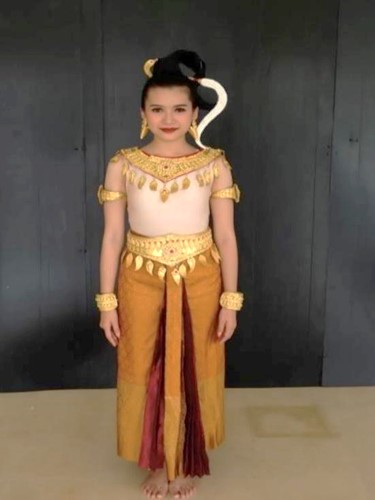นาฏศิลป์สร้างสรรค์ ชุด บุพเพจีตราเนียง
-
คำสำคัญ:
นาฏศิลป์ไทย, นาฏศิลป์สร้างสรรค์, บุพเพจีตราเนียงบทคัดย่อ
นาฏศิลป์สร้างสรรค์ชุด บุพเพจีตราเนียง มีวัตถุประสงค์เพื่อสร้างสรรค์นาฏศิลป์ชุดใหม่โดยการศึกษาแนวทางจากความเป็นมาของอาณาจักรขอมโบราณ การถวายตัวในยุคของขอม เพื่อนำมาสร้างสรรค์ผลงานทางด้านนาฏศิลป์ ชุด บุพเพจีตราเนียง หมายถึง การตีตรา ในโชคชะตาของหญิงสาว ซึ่งได้ศึกษาจากเรื่องราวของนางห้าม อันเกี่ยวข้องกับภาพจำหลักนางอัปสรา ซึ่งได้เชื่อมโยงศิลปะทางด้านสถาปัตยกรรมกับปราสาทศีขรภูมิ ที่สร้างขึ้น ตามรูปแบบศิลปกรรมขอมโบราณ ตรงกับศิลปะสมัยบาปวนสืบเนื่องถึงสมัยนครวัด จึงเป็นหลักแนวคิดนำมาถ่ายทอดสู่กระบวนท่ารำในรูปแบบนาฏศิลป์สร้างสรรค์ โดยใช้นักแสดงทั้งหมด 12 คน เป็นนักแสดงหญิง 10 คน นักแสดงชาย 2 คน มีท่ารำ 76 รูปแบบ ทิศทางการแปรแถวมี 20 แบบ การแต่งกายนั้นได้ศึกษาจากภาพจำหลัก รูปปั้นนางอัปสราของนครวัด นครธม ของประเทศกัมพูชา นางอัปสราสวมชุดเข้ารูปแขนกุด และนุ่งผ้าจีบหน้านาง มีเครื่องประดับศีรษะเสียบกับมวยผม เครื่องแต่งกายกษัตริย์ นุ่งผ้าแบบจีบโจง สวมศีรษะตามแบบภาพจำหลักของกษัตริย์ขอม นอกจากนี้ยังแต่งลายเพลงขึ้นมาใหม่ โดยใช้เครื่องดนตรีอีสานใต้ผสมผสานกับเครื่องดนตรีสากล เพื่อเพิ่มอารมณ์ความรู้สึกของเพลงในการแสดง โดยรูปแบบการแสดงแบ่งออกเป็น 3 ช่วง ช่วงที่ 1) เหล่าสตรี นวยนาฏ ยาตรา ช่วงที่ 2) ถวายบำเรอท้าวไท้ ช่วงที่ 3) โทษทัณฑ์นางห้าม
เอกสารอ้างอิง
กิตติ โล่ห์เพชรัตน์. (2556). ขอมโบราณ ย้อนตำนานวัฒนธรรมบรรพบุรุษเก่าแก่แห่งอุษาคเนย์. กรุงเทพฯ: ก้าวแรก พับลิชชิ่ง.
กิตติชัย ปีณะสา. (2558). ยลสราญนางเทวี. ศิลปนิพนธ์ปริญญาศิลปบัณฑิต สาขาวิชาศิลปะการแสดง คณะมนุษยศาสตร์และสังคมศาสตร์ มหาวิทยาลัยราชภัฏอุดรธานี.
ธรรมรัตน์ โถวสกุล. (2543). นาฏยศิลป์ในงานโครงการนาฏยศิลป์ของภาควิชานาฏศิลป์คณะศิลปะกรรมศาสตร์ จุฬาลงกรณ์มหาวิทยาลัย. วิทยานิพนธ์ปริญญาศิลปกรรมศาสตรมหาบัณฑิต สาขาวิชานาฏศิลป์ไทย จุฬาลงกรณ์มหาวิทยาลัย.
มยุรี วีรประเสริฐ. (2545). การแพร่หลายอารยธรรมเขมรโบราณและหลักฐานโบราณคดีสมัยลพบุรี. กรุงเทพฯ: ภาควิชาโบราณคดี คณะโบราณคดี มหาวิทยาลัยศิลปากร.
ยุวดี พลศิริ. (2563). การสร้างสรรค์การแสดงนาฏยประดิษฐ์ ระบำเทวีอัปสราตาเมือนธม สู่การท่องเที่ยวเชิงวัฒนธรรม. สุรินทร์: สาขาวิชานาฏศิลป์ คณะมนุษย์ศาสตร์และสังคมศาสตร์ มหาวิทยาลัยราชภัฏสุรินทร์.
สุรพล วิรุฬห์รักษ์. (2543). นาฏยศิลป์ปริทรรศน์. กรุงเทพฯ: ห้องภาพสุวรรณ.
สุรัตน์ จงดา. (2564). “อิทธิพลละครวังหน้าในนาฏศิลป์กัมพูชา”. วารสารวิพิธพัฒนศิลป์, 1, 2: 33-50.

ดาวน์โหลด
เผยแพร่แล้ว
ฉบับ
ประเภทบทความ
สัญญาอนุญาต
ลิขสิทธิ์ (c) 2024 วารสารพัฒนศิลป์วิชาการ

อนุญาตภายใต้เงื่อนไข Creative Commons Attribution-NonCommercial-NoDerivatives 4.0 International License.
บทความที่ได้รับการตีพิมพ์เป็นลิขสิทธิ์ของ สบศ.





